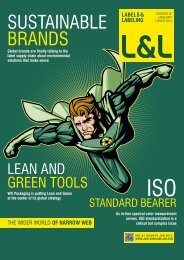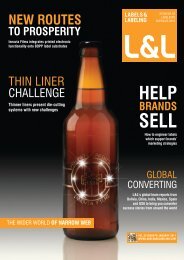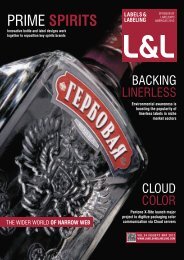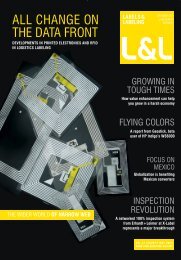Create successful ePaper yourself
Turn your PDF publications into a flip-book with our unique Google optimized e-Paper software.
30 | L&L<br />
Making the most<br />
of your sticky business<br />
BY BOB CRONIN of the Open Approach asks whether you are investing enough in making your employees<br />
and customers ‘stick’<br />
Pressure-sensitive, cut-and-stack, shrink sleeve, packaging,<br />
product identification. Whatever your business, you likely spend<br />
a large percentage of gross annual revenues on the adhesive<br />
properties of your products. You review suppliers, evaluate<br />
environmental and recyclability issues, and test formulations.<br />
And you are likely look to at Labels & Labeling to introduce you<br />
to new possibilities to achieve greater manufacturing success.<br />
Indeed, glues and adhesive substrates are key to what you<br />
produce, and they deserve every bit of attention and cost you<br />
wish to expend.<br />
But what about the ‘stickiness’of your customers and<br />
employees? What expenses are you dedicating to ensure their<br />
adhesion to your business? What programs and opportunities<br />
have you established that specifically address these<br />
constituencies and their needs? You can market yourself by<br />
products, services, equipment, and capabilities. You can boast<br />
about your competitive advantages and your cutting-edge<br />
digital press or unique die-cutting ability. But it all boils down<br />
to your people. This is how you are really judged in the<br />
marketplace.<br />
Every credible M&A transaction centers on an examination of<br />
customers and employees. And no discussion about company<br />
preparation – on either the selling or buying side – would be<br />
complete without addressing these crucial resources.<br />
Though less tangible than the xxx-per-minute output<br />
device, the human element remains the essential factor in the<br />
ongoing health – and growth – of every business. In today’s<br />
electronically driven world, this can be easy to forget. You may<br />
think your neighbor’s next-generation systems platform will<br />
automatically give them a higher value. Or that more equipment<br />
will be more attractive to prospective investors. But the truth<br />
remains: Nothing drives prosperity in the label industry more<br />
than your customers and employees. And thus, any wise<br />
acquirer is going to review both of these, just as thoroughly as<br />
they do your financial data and value proposition.<br />
THE STICKY CUSTOMER<br />
When you put your company up for sale, every acquirer will<br />
ask for information on your accounts. Reviewing your customer<br />
list, length of relationships, and retention rate/account turnover<br />
can tell an acquirer about how you are viewed by the client<br />
and the marketplace at large. It can indicate where you stand<br />
competitively and how you compare to similar properties. Your<br />
top 10 customer list and historical performance can also help<br />
give them a picture of the value of the business based on the<br />
ability to secure and retain customers and the cash flow they<br />
generate.<br />
Surprisingly, very few selling companies have this information<br />
readily available. In fact, many times, this information is<br />
relegated to the chief financial Rottweiler or company auditor.<br />
Yet, understanding your best customers is something that really<br />
needs to be done by everyone in a customer-facing position<br />
– sales team, customer service reps, etc. And it’s not just a<br />
matter of determining who they are, it’s about finding out what<br />
LABELS&LABELING<br />
it is about your company that keeps them onboard. In order<br />
to create new sticky customers, you really should understand<br />
what you’re doing right – or wrong. From there, you can apply<br />
that same thinking as you develop new relationships.<br />
Many companies neglect their long-time loyals or top 10,<br />
focusing efforts on winning new ‘whales’ or trying to fight the<br />
never-ending bidding wars. True, in today’s marketplace, we<br />
are all confronted by the issue of price. And it’s an important<br />
topic to confront. Never do you hear you are not charging<br />
enough, but often you hear that you are charging too high, or<br />
not competitive. You’ll hear this from every type of client, with<br />
the intimation being that they might change suppliers. But<br />
change equals risk, and the reality is that conversion to a new<br />
label provider can be extremely painful to the customer – and<br />
not likely the path they want to take. Their negotiation with you<br />
may simply be a strategy to keep you competitive and keep<br />
their management teams assured they are spending wisely.<br />
At the same time, there are dozens of prospects that you have<br />
been calling on for years that have never done business with<br />
you – even though you know you can price more competitively<br />
than their current supplier. Truly, price is not the end-all, be-all.<br />
This may be the reason we hear for not getting a particular<br />
project or landing a particular client. But that’s simply because<br />
it’s the easiest answer to give –by the client and by the sales<br />
rep. Price may be an issue, and sometimes concessions may<br />
be necessary. Overall, however, there are at least 10 other<br />
factors that weigh heavier on the typical purchasing decision.<br />
As you view your customer list, you likely have a group of<br />
companies that have been with you a long time. In many ways,<br />
their success has been the basis of yours. Somehow you have<br />
aligned your goals with theirs, and that alignment creates the<br />
value that transforms a relationship from ‘vendor’ to ‘partner.’<br />
You do not treat them simply as ‘revenues,’ and in turn they do<br />
not judge you simply on ‘price.’<br />
So what is it that you bring them? Perhaps it’s a full<br />
solution. Perhaps it’s the ease of dealing with you. Perhaps<br />
it’s the knowledge you have of their unique business or the<br />
appreciation you show them for their work. Whatever it is,<br />
it’s the adhesive you need to be formulating for use in all<br />
your customer development and retention strategies – efforts<br />
that should be every bit as tangible and meaningful as other<br />
operational activities.<br />
THE STICKY EMPLOYEE<br />
Likewise, your employees are not simply with your company<br />
‘because they are getting paid.’ People invest a good portion<br />
of their waking life at work and choose to be at their respective<br />
workplaces for varying reasons. Sure, a paycheck is important,<br />
but the most valuable employees are those that are connected<br />
– ‘sticky’ to your company – by means other than the mighty<br />
dollar.<br />
Employee tenure is another big consideration in the<br />
acquisition process. Immediately, it can speak to your<br />
company’s experience, and thus to the ability to integrate new
















